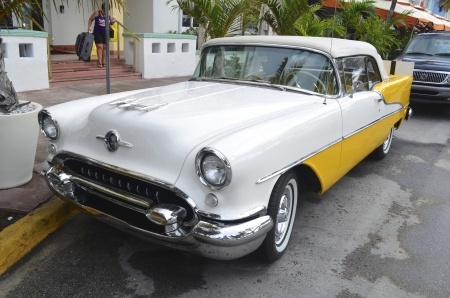Let’s Save Oldsmobile!
Fire up the Wayback Machine, Mister Peabody!
We’re going to rescue General Motors! Save the Oldsmobile brand! Really. Once we, um, get the last few pesky details of this time travel thing ironed out.

The Olds brand was clearly AMF (as they say on hospital charts: the significant first word being Adios) and quite beyond resurrection years ago.
Brand death is not a natural inevitability, by the way. As much as you may hear about product life cycles, and as often as you may be lulled into thinking of a brand’s natural life span from the metaphors we use about birth and maturity… brands do not have to die.
Some brands can be immortal. Of course, it takes
a) the continuing need for the underlying product(s)
b) investment in continual improvement
c) the occasional revival
d) wise stewardship, and
e) a little luck. (Among brandholders, the conjunction of prudent stewardship and luck is rare enough that long-life brands are relatively few … but they do exist.)
Obviously, Oldsmobile did not survive: the seeds of the brand’s demise were planted long ago, leading to a long slow death spiral.
Which leads us to the question we really do want to pose:
If you could spin the clock back to some point where Oldsmobile could be saved, how many years back would you have to go? And what would you do?
(This is essay, not multiple choice. Please fill your blue book. And no peeking.)
Okay. Just as soon as we get that flux capacitor out of the lab, we think perhaps we should travel back to (drum roll, please) 1956, when Oldsmobile was popular, and the brand was truly differentiated from competitors. (See the picture above.) You could even tell a Buick from an Olds, at a distance. Imagine that. Shazam, fellow time travelers (“Chronoguard, SpecOps-12”?) here we are, back in the Eisenhower years, disguised to blend in, with white bucks and crew cuts, poodle skirts and ponytails. Hide that iPad. One of the first things that strikes us as we look around Mel’s drive-in is that Olds markets two powerful, memorable, visual model names: a Rocket 88 and a Rocket 98 — what the hell is an Alero, anyway?
It’s possible to see, with lasik-corrected hindsight, that the nagging problem of one crucial Brand Asset, the Name, could easily be changed, with all proper evolutionary-not-revolutionary caution, from that 1956 point forward.
Aha. We can build a strategic plan where “Rocket ” evolves into the brand, replacing the unfortunate Old Slow Mobile, which gets pushed into the background to fade away over the course of say, 5 years. This strategic left turn wipes out the need for those limp, apologetic “Youngmobile” and “Not your father’s Oldsmobile” campaigns that tried but spectacularly failed to rescue the brand over the next three decades.
Of course, this hypothetical solution takes far more than getting the DeLorean up to 88 mph … it also requires a hypothetical General Motors who would need the, ahem, pistons to make a radical change in their successful ongoing 1956 marketing strategy. When you’re smug and complacent, there’s little incentive to change. (They’d also need the vision to listen to people dressed in white bucks and poodle skirts, which, when you think about it, is a close cousin to the smugness problem.) Then, beyond 1956, they’d also have to maintain stewardship of the newly evolved Rocket brand … without screwing up. Not a GM strength, it seems: over the years, in the brand’s death spiral, they might have found many other ways to fail.
Moral of the story? The strategic marketer can (and often must) retool a brand even when it’s successful. (“If it ain’t broke … hold on … is it possible our weakest Brand Asset, the one we think just needs a little tinkering, could eventually become septic and drag the brand to the edge of real trouble?”) Even when your brand is going strong, it’s a good time to conduct a Brand Asset Audit. Invest the time and effort to see where your brand needs a little bandage … or a little therapy, or major surgery … long before the only remaining hope is a band of ponytailed time-traveling exorcists.